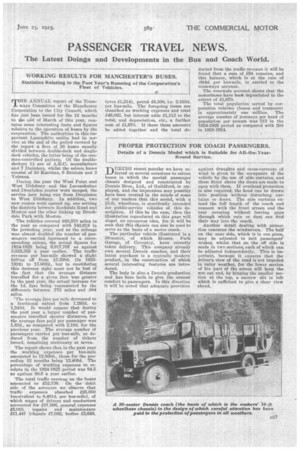PASSENGER TRAVEL NEWS.
Page 21

If you've noticed an error in this article please click here to report it so we can fix it.
The Latest Doings and Developments in the Bus and Coach World.
WORKING RESULTS FOR MANCHESTER'S BUSES.
Statistics Relating to the Past Year's Running of the Corporation's :Fleet of Vehicles.
rpm: ANNUAL report of the Tram ways Committee of the Manchester Corporation to the City Council, which has just been issued for the 12 months to the end of March of this year, contains some interesting facts and figures relative to the operation of buses by the corporation. The authorities in this important Lancashire centre had in service at the end of the period covered by the report a fleet of 36 buses equally divided between double-deck and singledeck vehicles, the latter being of the oneman-controlled pattern. Of the doubledeckers 11 are of A.B.C. manufaeture and 7 Daimlers, whilst the saloon buses consist of 10 liarriers, 6 Bristols and 2 Vuleans.
During the year the West Point and West Didsbury and the Levenshuline and Droyladen routes were merged, the service now being run from Droylsden to West Didsbury. In addition, two new routes were opened up, one serving the districts between Rochdale Road and Moston and the other linking up Brookdale Park with Moston.
The vehicles covered 930,578 miles in the year as compared with 543,618 in the preceding year, and as the mileage was almost doubled the number of passengers carried increased to a corresponding extent, the actual figures for 1924-1925 being 6,917,707 as against 3,823,355 a year earlier. The traffic revenue per bus-mile showed a slight falling off from 15.350d. (in 19231924) to 13.6020., but in considering this decrease sight must not be lost of the fact that the average distance travelled for a given fare was greater in the past year, the actual increase for the 10. fare being represented by the difference between .773 miles mid .804 miles.
-'The average fare per mile decreased to a fractional extent from 1.2930. to 12430. It would appear that during the past year a larger number of passengers travelled shorter distances, for the average fare paid per passenger was 1.830., as compared with 2.180. for the previous year. The average number of passengers carried per bus-Wile, as dedueed from the number of tickets issued, remaining stationary at seven.
The report shows that in the past year the working expenses per bus-mile amounted to 12.8600., those for the preceding 12 months being 12.4080. The percentage of working expenses to receipts in the 1924-1925 period was 94.5 as against 80.8 a year earlier.
The total traffic revenue on the 'bus amounted to 152,729. On the debit aide of the accounts we observe that traffic expenses absorbed £25,050 (equivalent to 6A610. per bue-mile), of which wages of drivers and conductors aecounted for £17,596, general expenses 15,015. repairs and maintenance £11,447 (chassis 17,092, bodies £2,649, tyres £1,214), petrol £8,350, i.e. 2.153th per bus-mile. The foregoing items are classified as working expenses and total 149,862, but interest adds £1,113 to the total, and depreciation, etc., a further sum of £1,670. If these three amounts be added together and the total de ducted from the traffic revenue it will be found that a sum of £94 remains, and this balance, which is at the rate of .024d. per bus-mile, is carried to the tramways account.
The renewals account shows that the motorbuses have bees depreciated to the extent of 11,670.
The total population served by corporation vehicles (buses and tramcars) is approximately one million. The average number of journeys per head of population per annum was 812 in the 1924-3925 period as compared with 298 in 1923-1924.






























